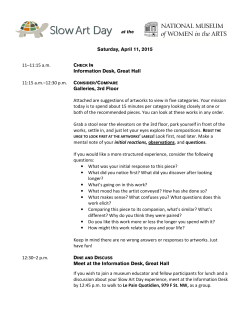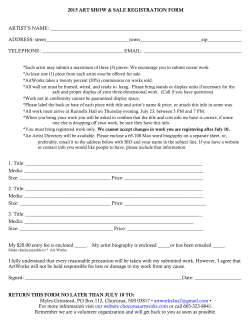
TEKS Correlations
TEKS Correlations Explorations in Art, Grade K, Teacher Book Use this chart to identify exemplary lessons that match the TEKS. Additional matches can be found throughout the book. Explorations in Art, Grade K, Teacher Book LESSONS TEKS Pages 1A l eBook Correlation 1B 2A 2B 2C UNIT 1 6-7 Lesson 1 8-9 Lesson 2 10-11 ll Lesson 3 12-13 ll Lesson 4 14-15 Lesson 5 16-17 Lesson 6 18-19 ll Lesson 7 20–21 ll Lesson 8 22–23 3A ll 3B 3C l Printed Textbook Correlation 3D 4A 4B ll ll ll ll UNIT 2 Lesson 1 24-25 Lesson 2 26-27 Lesson 3 28-29 ll ll ll ll ll ll UNIT 3 Lesson 1 30-31 Lesson 2 32-33 Lesson 3 34-35 Lesson 4 36-37 ll ll ll ll ll UNIT 4 Lesson 1 38-39 Lesson 2 40-41 Lesson 3 42-43 ll Lesson 4 44-45 ll DAVIS PUBLICATIONS • DAVISART.COM • ll ll ll 800.533.2847 ll ll • FA X 508.753.3834 • 4C ll ll CONTACTUS @ DAVISART.COM ll TEKS Correlations 2 Explorations in Art, Grade K, Teacher Book LESSONS TEKS Pages 1A l eBook Correlation 1B 2A ll 2B 2C 3A 3B 3C l Printed Textbook Correlation 3D 4A UNIT 5 Lesson 1 46-47 ll Lesson 2 48-49 ll Lesson 3 50-51 ll Lesson 4 52-53 ll Lesson 1 54-55 ll Lesson 2 56-57 ll Lesson 3 58-59 ll Lesson 4 60-61 ll ll ll ll ll UNIT 6 ll ll UNIT 7 Lesson 1 62-63 Lesson 2 64-65 UNIT 8 Lesson 1 66-67 Lesson 2 68-69 Lesson 3 70-71 ll ll ll ll UNIT 9 Lesson 1 72-73 Lesson 2 74-75 ll Lesson 3 76-77 ll ll ll UNIT 10 Lesson 1 78-79 Lesson 2 80-81 Lesson 3 82-83 DAVIS PUBLICATIONS • DAVISART.COM • l ll 800.533.2847 ll • FA X 508.753.3834 • CONTACTUS @ DAVISART.COM 4B 4C TEKS Correlations 3 TEKS Descriptions (1) Foundations: observation and perception. The student develops and expands visual literacy skills using critical thinking, imagination, and the senses to observe and explore the world by learning about, understanding, and applying the elements of art, principles of design, and expressive qualities. The student uses what the student sees, knows, and has experienced as sources for examining, understanding, and creating artworks. The student is expected to: (A) explore ideas from life experiences about self, peers, family, school, or community, and from the imagination as sources for original works of art (B) use appropriate vocabulary when discussing the elements of art, including line, shape, color, texture, form, space, and value, and the principles of design, including emphasis, repetition/pattern, movement/rhythm, contrast/variety, balance, proportion, and unity (C) discuss the elements of art as building blocks and the principles of design as organizers of works of art (2) Creative expression. The student communicates ideas through original artworks using a variety of media with appropriate skills. The student expresses thoughts and ideas creatively while challenging the imagination, fostering reflective thinking, and developing disciplined effort and progressive problem solving skills. The student is expected to: (A) integrate ideas drawn from life experiences to create original works of art (B) create compositions using the elements of art and principles of design (C) produce drawings; paintings; prints; sculpture, including modeled forms; and other art forms such as ceramics, fiber art, constructions, mixed media, installation art, digital art and media, and photographic imagery using a variety of materials DAVIS PUBLICATIONS • DAVISART.COM • 800.533.2847 • (3) Historical and cultural relevance. The student demonstrates an understanding of art history and culture by analyzing artistic styles, historical periods, and a variety of cultures. The student develops global awareness and respect for the traditions and contributions of diverse cultures. The student is expected to: (A) identify simple main ideas expressed in artworks from various times and places (B) compare and contrast artworks created by historical and contemporary men and women, making connections to various cultures (C) connect art to career opportunities for positions such as architects, animators, cartoonists, engineers, fashion designers, film makers, graphic artists, illustrators, interior designers, photographers, and web designers (D) investigate the connections of visual art concepts to other disciplines (4) Critical evaluation and response. The student responds to and analyzes artworks of self and others, contributing to the development of lifelong skills of making informed judgments and reasoned evaluations. The student is expected to: (A) evaluate the elements of art, principles of design, or expressive qualities in artworks of self, peers, and historical and contemporary artists (B) use methods such as oral response or artist statements to identify main ideas found in collections of artworks created by self, peers, and major historical or contemporary artists in real or virtual portfolios, galleries, or art museums (C) compile collections of personal artworks such as physical artworks, electronic images, sketchbooks, or portfolios for purposes of self assessment or exhibition FA X 508.753.3834 • CONTACTUS @ DAVISART.COM
© Copyright 2025










